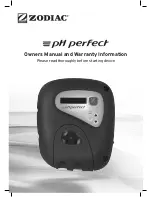
P o w e r D e f e n d e r 1 4 0 f o r W a t e r w a y P o o l P u m p M o t o r
I n s t a l l a t i o n a n d O p e r a t i o n M a n u a l
30
Maintenance
Before performing any maintenance on the pump, disconnect electrical power. Allow the motor to come
to a complete stop and wait two (2) minutes. This allows the bus capacitors in the control to discharge
any residual voltage.
·
Periodically inspect the installation. Check for dirt accumulation, unusual noises or vibration,
overheating, worn or loose couplings, high motor amps, poor wiring or overheated connections,
loose mounting bolts or guards, and worn motor starter contacts. Check all wiring harnesses and
control connectors. Inspect for shorts, detached wiring, or loose connections.
·
Remove any debris accumulation, particularly in and around vent openings by vacuuming. Dirt or
debris accumulation can jam the impeller, cause motor overheating, and is also a fire hazard.
·
Do not
use solvents! Some solvents may attack motor insulation, finish, or bearing lubricants.
Solvents are highly flammable.
·
Ball bearing motors are permanently lubricated. No maintenance is required.
Lowering Your Utility Costs
Your electric bill is based on the number of Kilowatts used in a typical billing cycle. Each Kilowatt is
1,000 watts. To calculate how much energy your current pool motor is using and to calculate the savings
potential your pool pump motor, visit our web site and use the
Energy Calculator
.
(http://www.usmotors.com/PoolEnergyCalc)
The calculator uses US Dollars (USD) for savings calculation only. The calculator will show you how
many hours to run your pump each day, along with the appropriate speed for maximum energy savings.
Contact your utility company to determine peak demand times of day or the times of day during which
higher utility costs are charged to the customer. Then, program your motor either not to run at all, or to
run at very low RPMs during these periods.
Example Calculations
By reducing your speed to 50% RPM, the horsepower requirement is reduced to 1/8th of the 100%. The
calculation is as follows:
(50/100 * 50/100 * 50/100) =.125 or 12.5%.
To run the pump at 30% RPM, the calculation is as follows:
(30/100 * 30/100 * 30/100) = 0.027
This would be 2.7% of the previously used Max HP. Lower utility cost is a primary advantage of the
Power Defender 140 for Waterway Pool Pump Motor. Try out the
Energy Calculator
to determine your
energy savings by reducing the speed while enabling the proper amount of daily flow needed to filter
your pool.





































